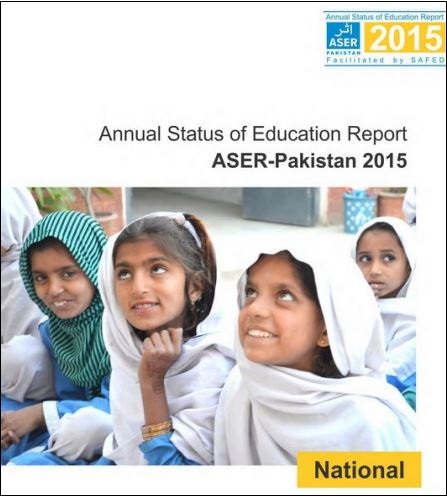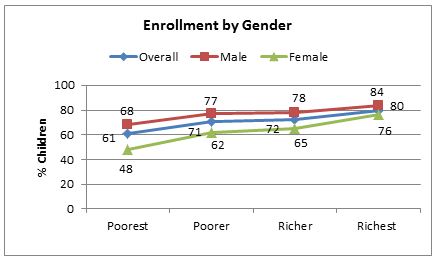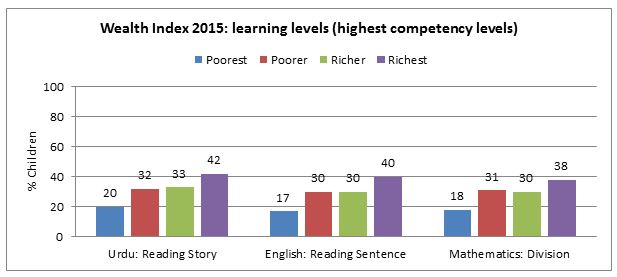ASER 2015 Results from Pakistan: Making the Invisible Visible By Sehar Saeed
By Sehar Saeed, Annual Status of Education Report (ASER), Pakistan.
 The recently launched ASER Report 2015 is a testament to civil society evidence-based activism that has drawn irreversible attention to the crisis of learning, both locally and globally. As we move forward towards the recently adopted Sustainable Development Goals (SDGs), we are reminded that the ‘learning plus access’ agenda for the education SDG (SDG ) would not have happened without the firm backing of the citizen-led nationwide assessments in Pakistan, South Asia and Africa. ASER Pakistan, ASER India, Uwezo in Kenya, Uganda, and Tanzania, Beekunko in Mali, Jàngandoo in Senegal, Medición Independiente de Aprendizajes (MIA) in Mexico, and LEARNigeria in Nigeria have emerged powerfully as the People’s Action for Learning Network (PAL Network) which believes in the power of involving citizens for creating learning accountability.
The recently launched ASER Report 2015 is a testament to civil society evidence-based activism that has drawn irreversible attention to the crisis of learning, both locally and globally. As we move forward towards the recently adopted Sustainable Development Goals (SDGs), we are reminded that the ‘learning plus access’ agenda for the education SDG (SDG ) would not have happened without the firm backing of the citizen-led nationwide assessments in Pakistan, South Asia and Africa. ASER Pakistan, ASER India, Uwezo in Kenya, Uganda, and Tanzania, Beekunko in Mali, Jàngandoo in Senegal, Medición Independiente de Aprendizajes (MIA) in Mexico, and LEARNigeria in Nigeria have emerged powerfully as the People’s Action for Learning Network (PAL Network) which believes in the power of involving citizens for creating learning accountability.
The education SDG carries a sector wide, ambitious and aspirational approach for ensuring all children and young people, regardless of their background, acquire relevant learning outcomes by 2030. Within SDG 4 target in particular, a lower-primary assessment goal has now been added for tracking proficiency in literacy and numeracy. The data provided by the ASER Report thus serves as an invaluable resource for setting the ground and understanding the extent of the learning crisis in order to meet the planned targets. The ASER 2015 survey was conducted in 146 rural districts of Pakistan, covering 83,755 households in 4,217 villages throughout the country. Detailed information was collected on 258,021 children (59% males, 41% females) aged 3-16 years. Out of these 219,609 children aged 5-16 years were tested for language and arithmetic competencies.
National rural findings revealed that 45% enrolled in class 5 still were not able to read a class two level story in their local language i.e. Urdu/Sindhi/Pashto. The situation is even more dire for English and Math. 51% of class 5 children could not read sentences in English (class 2 level) while 50% could not solve two digit division sums. Moreover, children enrolled in private schools were found to be performing better than those who were going to their government counterparts. But students studying in private schools were also observed to be taking more tuition when compared to government schools students.
The ASER 2015 data set also highlights the appalling access and gender disparities created in terms of enrollment and learning levels because of differences in wealth status. The indicators captured through household questionnaire measures the economic potential and achieved levels of income /wealth of a household.
The results reveal that the richest quartile has the highest percentage of children enrolled (80%) whereas the poorest quartile has the lowest enrollment rate (61%). A strong correlation between wealth and enrollment is established as we move along the wealth index. Moreover, socio-economic background is also found to be influencing gender inequity. The males and females belonging to the poorest quartile are particularly disadvantaged as depicted by the lowest enrollment rates. The most alarming trend is that of female’s enrollment which not only decreases across all quartiles but is also lower than the enrollment rate of males across all quartiles.

Not only enrollment, but also the learning levels of all three competencies i.e. Urdu/Sindhi/Pashto, English and Math are found to be affected by the wealth of a household. The graph below clearly indicates that the learning level of children in all three subjects increases as we move along the wealth index towards the richest quartile. The poorest have the lowest learning levels (20% Urdu/Sindhi/Pashto, 17% English, and 18% Math) and the richest have the highest learning levels (42% Urdu/Sindhi/Pashto, 40% English, and 38% Math). The households with a better wealth status are able to spend significantly more on their children’s education improving their opportunities for better quality schooling as reflected by the enrollment figures mentioned above.
 The analysis illustrates the long way to go to ensure all children even achieve one of the most modest of the sustainable development targets. In particular, it puts the spotlight on the need for reforms to start in the early years of pre-primary and primary schooling when learning gaps begin to form. It also highlights the importance of focusing attention on the poorest who have the furthest distance to travel if they are all to be able to achieve even the most basic skills by 2030.
The analysis illustrates the long way to go to ensure all children even achieve one of the most modest of the sustainable development targets. In particular, it puts the spotlight on the need for reforms to start in the early years of pre-primary and primary schooling when learning gaps begin to form. It also highlights the importance of focusing attention on the poorest who have the furthest distance to travel if they are all to be able to achieve even the most basic skills by 2030.
The SDG agenda calls for an explicit focus on equity, including equity-specific goals and the ASER participatory model captures not just national averages but also the variation across different population subgroups defined by group and individual characteristics, such as sex, wealth, and location. It has a unique role to play in informing the general public, inspiring national discourse and demand for policy and action leading to transformation from the bottom-up.
Sehar Saeed is serving as Program Head at ASER Pakistan. Email: sahar.sd@gmail.com
NORRAG (Network for International Policies and Cooperation in Education and Training) is an internationally recognised, multi-stakeholder network which has been seeking to inform, challenge and influence international education and training policies and cooperation for almost 30 years. NORRAG has more than 4,500 registered members worldwide and is free to join. Not a member? Join free here.

Pingback : Through Aditi’s Eyes: The Importance of Early Grade Assessment in Tracking Children’s Learning | NORRAG NEWSBite
Pingback : NORRAG – Through Aditi’s Eyes: The Importance of Early Grade Assessment in Tracking Children’s Learning By Hannah-May Wilson - NORRAG -